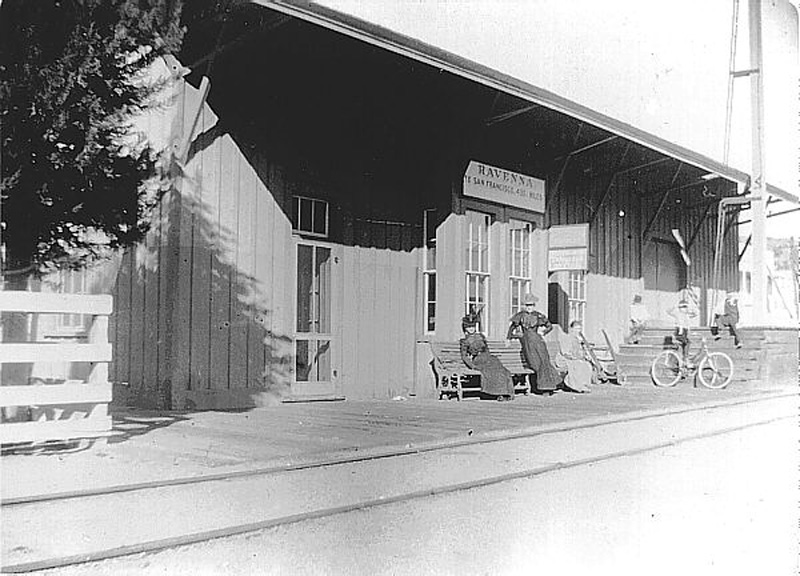|
|
Ravenna Train Station
Soledad Canyon

Southern Pacific Railroad depot at Ravenna — 430 miles southeast of San Francisco, as the sign in this circa 1900 photograph points out.
About Ravenna.
It is unlikely that any more than a few dozen people ever lived in the little mining town of Ravenna at any one time, but the town nonetheless sported a full train station. It was located four miles southwest of Acton in Soledad Canyon.
A number of miners, most notably Colonel Thomas Finley Mitchell, arrived in Soledad Canyon in 1860 and set up various mining camps near the canyon's rich veins of gold, silver and copper, which came into great demand when the Civil War broke out only a year later. Local historian Jerry Reynolds writes (in "Santa Clarita: Valley of the Golden Dream"):
"A conglomeration of log cabins and tents moved up and down the canyon with each new strike. Called 'Soledad City' wherever it was plunked down, it provided such basic needs as faro tables, rye whiskey, and ladies of the evening. A portable grocery was operated by James O'Reilly, a flaming-haired Irishman of medium build, pug nose, and happy-go-lucky air about him."
It wasn't long before a post office was needed, and as one might expect, the U.S. Postal Service rejected the name "Soledad City" out of fear that it would be confused with the city of Soledad in Monterey County. O'Reilly suggested the name "Ravenna," in honor of the local merchant and saloon keeper, Manuel Ravenna. The name became official June 12, 1868.
Ravenna became a shipping point from which gold, silver, copper and other minerals were hauled off to the port at San Pedro. Freight wagons drawn by oxen or mules were used at first; they gave way to rail cars after the first steam locomotives chugged through the canyon in 1876. In 1885 a paper mill was set up to pulp Joshua trees from the Antelope Valley, but it fell out of use by 1889 because the paper was of poor quality.
Besides precious and semi-precious metals, the area was also rich in a variety of gemstones, particularly moss agate and green waxy quartz, which were hunted in the 1950s.
While strip mining is still a big industry in the Soledad and in parts of the neighboring Mojave Desert, the little mining camp of Ravenna — and its rather sizable train station — are nothing more than faded memories.
The site owner makes no assertions as to ownership of any original copyrights to digitized images. However, these images are intended for Personal or Research use only. Any other kind of use, including but not limited to commercial or scholarly publication in any medium or format, public exhibition, or use online or in a web site, may be subject to additional restrictions including but not limited to the copyrights held by parties other than the site owner. USERS ARE SOLELY RESPONSIBLE for determining the existence of such rights and for obtaining any permissions and/or paying associated fees necessary for the proposed use.